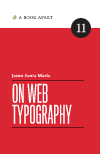Discourse in web design
Back in 2007, Speak Up—the web’s town hall for graphic design—asked where were the landmark achievements in web design. Where were web’s design equivalents to Milton Glaser’s Dylan poster, Paula Scher’s Public Theater work, or Massimo Vignelli’s New York subway map?
At the time I felt outrage. Were these graphic designers really throwing the whole of web design on a heap? Did people really not consider what we made real design?
What about Doug Bowman’s monumental work on 2002’s WIRED.com redesign, one of the first sites that showed us all that Web Standards and CSS could happen on something beyond our personal sites? How about Joshua Davis’ Praystation, who revealed complex animated interactions to a static web? Or communities like k10k that helped spread the message of good design and culture to all us practitioners?
None of these fit easily into the mold of a beautifully typeset poster on the side of a building, but these were more than websites or landmarks, they were full blown movements! Why couldn’t they see that?
I didn’t say anything about it at the time because I never felt I could articulate a response—the answers seemed apparent to me. The thoughts never went away, but I opted to just keep trying to make the best work I was able.
A recent tweet from Mark Boulton brought it all back again: “Graphic Design had Emigré. What does web design have?”
Of course! Emigré was the periodical for design culture and discourse. I read it religiously when I was in school and afterwards. The essays they published helped shape the way I thought about design. That kind of critical discourse about design on the web is all but non-existent.
We talk all the time on our personal and periodical sites about the latest techniques for design, but how often do we break down new designs? I mean really discuss them, not just add them to a gallery of notable sites.
Aesthetics are just one lens we can use to look at web design. Culture, time, place, and technology are others. Some websites look and act the way they do because of the state of technology during the time they were made. The landscape of architecture was changed by the invention of steel, just as the landscape of web was change by Flash, CSS, mobile phones, and Retina screens.
What’s more, graphic design critics and teachers constantly use these past landmarks to bring context to history, today’s design, and as a common measuring stick for what’s successful. On the web, we commonly move on to the newest things that displace what came before.
If work like Bowman’s WIRED.com website was so wonderful, does the fact that it isn’t suited to today’s web diminish that fact? We can build websites faster and smarter than we used to, they can respond to being viewed on screens as small as our mobile phone or as large as our televisions, but the work we do today is important for another reason.
We are all standing on the shoulders of the work that came before us—just as Vignelli’s subway poster was influenced by Henry Beck’s 1933 London Underground map, and Glaser’s Dylan poster was influenced by a 1957 self-portrait from Marcel Duchamp. Will new students to web design know of these same connections in their own field, or will the work done before their time always be quaint artifacts of a bizarre, retro internet where aliased type, tables, browser plugins, and slow connections ruled the land? Or worse, will they never know of the work at all?
If we are only able to judge web design through the lens of print design, we’re doomed to never measure up. Web designers know our work has very different parameters and constraints than the printed page. Even though we use many of the same raw materials—imagery, text, color, and grids—the results are very different. Why would you ever judge a website on the same scale as a poster?
A website is its own, singular thing. We know it isn’t a book, a TV show, a film, or a song, but our language is limited to talking about it in those restrictive boxes. A website is a mix of all of those things, and none of those things. It is influenced by place and time. A website changes with age. It can evolve and regress.
It was then I wondered if the problem wasn’t that web design lacked its own Emigré. What if we actually lacked a shared language to critically discuss web design? Art, architecture, and even graphic design, have critics and historians that give context to new work through the lenses of culture and important work from the past.
So where does a common language for discourse start? Not just one for us as web designers, but one that will give structure to others who don’t as deeply understand what we do?
The recent redesign of The New York Times perfectly illustrates the mindset of modern web design. The design itself is exceptional: solid typography, navigation, and further reinforcement to the visual language that makes The Times, well, The Times. While the general response has been positive, it’s bundled with some disappointment that the site didn’t innovate like “Snow Fall” or disrupt some paradigms.
The problem isn’t with The Times. In the last couple years, the site and their editorial design work has been brilliant. The problem is that we don’t have the right words to talk about this stuff, let alone the right context to find common ground for real discussion inside our industry or the folks just outside it. If our eyes are only attuned to the latest shiny thing, we can’t possibly understand anything of influence or consequence.
I realize I’m asking lots of questions, and I still don’t have the answers. I’m not a historian or a critic, I’m a practitioner. And perhaps that’s the key: maybe this needs to come from the outside, from people who can step back, see a larger picture of web design, and understand how it fits into everything else.
This piece originally appeared on The Pastry Box Project.
Afterword
The response to the above piece was really encouraging, thank you! I have a few additional thoughts and reactions:
Jeremy Keith kindly reminded me of his 2007 piece “Design doing” where he questions the same Speak Up article and ensuing discussion. Cennydd Bowles showed me his 2010 “Beauty in web design” series (parts 2 and 3) based where he tries to find the a language for talking about web design through the lens of beauty itself. And in “Perennial Design” (a preview of Issue 4 of The Manual), Wilson Miner wonders where we can find longevity in our designs. All are great and recommended reads.
Some folks responded on Twitter that publications like Offscreen and The Manual may be the web's Emigré. Both of those publications are wonderful, and though I bring up Emigré as an example, I think that it is a result of a larger scope of discourse rather than the only cause of it. We don't need our Emigré as much as we need the tools and environment that yields communication like it.
Others folks suggested that the web may be too young for us to really have perspective on its larger roll yet. The web has already gone through bubbles, Arab Springs, wars, elections, natural disasters, assassinations, and more as well as the minutiae of life at the global and local scale. The sites and applications we make have been there beside us the whole time, changing and growing to support and connect us across everything that happens in our daily lives. That we can lose something as important to the story of the web as GeoCities shows that we can’t hide behind the “too young” straw man any longer.
The AIGA is celebrating its centennial this year and is marking the occasion by showcasing the impact of design over the last 100 years. Only a few websites made the grade (including Facebook of all things), despite the web being around for over a fifth of that hundred years. Granted, the AIGA is still very much coming from a traditional graphic design mindset, but this shows that the value and reach of our work is not immediately apparent to designers from other walks.
As I said above, I’m a practitioner and I’m still wrapping my head around this stuff. We may lack answers to these questions, but that doesn’t mean they’re unreachable—just that we have work to do.





 The Form of the Book
The Form of the Book
